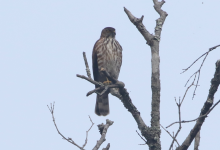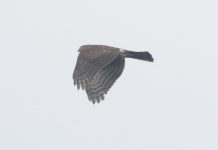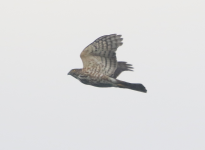-
Welcome to BirdForum, the internet's largest birding community with thousands of members from all over the world. The forums are dedicated to wild birds, birding, binoculars and equipment and all that goes with it.
Please register for an account to take part in the discussions in the forum, post your pictures in the gallery and more.
You are using an out of date browser. It may not display this or other websites correctly.
You should upgrade or use an alternative browser.
You should upgrade or use an alternative browser.
Eu. Sparrowhawk vs. Besra, India (1 Viewer)
- Thread starter Tiraya
- Start date
More options
Who Replied?Tiraya
San Diego CA

@greyfantail did you get better images of this bird?
Grahame Walbridge
Well-known member
True, this pair can be tricky but are readily separable given half decent images which, these are not! That said, despite the poor quality images, I am seeing 5 fingers and so would conclude Besra-Crested Goshawk shows 6 fingers.So the legends were true...no one really knows how to tell these birds apart!!
Grahame
Last edited:
Tiraya
San Diego CA

True, this pair can be tricky but are readily separable given half decent images which, these are not! That said, despite the poor quality images, I am seeing 5 fingers and so would conclude Besra-Crested Goshawk shows 6 fingers.
Grahame
Grahame, does the tail pattern not "rule out" Besra according to other thoughts?
The second bird at a different location had far more appreciable views.



Grahame Walbridge
Well-known member
In a word, no.Grahame, does the tail pattern not "rule out" Besra according to other thoughts?
The second bird at a different location had far more appreciable views.
Second individual is also a Besra. Note, in particular, small bill, slim tarsi and 5 fingers.
Crested Goshawk is an altogether more powerful bird with a larger bill, thicker tarsi which is partially feathered (not visible here) with obviously stronger, more powerful feet. The 'leggings' are finely barred black and the white undertail coverts are typically splayed and more extensive.
Grahame
Tiraya
San Diego CA

In a word, no.
Second individual is also a Besra. Note, in particular, small bill, slim tarsi and 5 fingers.
Crested Goshawk is an altogether more powerful bird with a larger bill, thicker tarsi which is partially feathered (not visible here) with obviously stronger, more powerful feet. The 'leggings' are finely barred black and the white undertail coverts are typically splayed and more extensive.
Grahame
Thanks Grahame!
Phew, I'm glad it wasn't a Eurasian sparrowhawk, if it was, that would have been the most "disappointing" outcome (considering it's the only "non-lifer" bird there I could have seen).
As I said in
I visit BF from a desktop machine with a 27-inch screen. But there doesn't seem to be a desktop Mac version of the Merlin software (only iPhone, iPad). So I installed it on my iPad, and then took a photo of the bird on my 27-inch screen using the iPad camera, and used this as the input to Merlin.
I attach the photo below. Yet it still came up with Besra, which is apparently the right answer!
Maybe young folk will think it's a great thing, but I'm old enough to think that it will be profoundly sad if software makes an interactive real-people forum such as this un-necessary.

As I said above, I was playing around with my iPad and thought I would try Merlin ID software just for fun.True, this pair can be tricky but are readily separable given half decent images which, these are not! That said, despite the poor quality images, I am seeing 5 fingers and so would conclude Besra-Crested Goshawk shows 6 fingers.
I visit BF from a desktop machine with a 27-inch screen. But there doesn't seem to be a desktop Mac version of the Merlin software (only iPhone, iPad). So I installed it on my iPad, and then took a photo of the bird on my 27-inch screen using the iPad camera, and used this as the input to Merlin.
I attach the photo below. Yet it still came up with Besra, which is apparently the right answer!
Maybe young folk will think it's a great thing, but I'm old enough to think that it will be profoundly sad if software makes an interactive real-people forum such as this un-necessary.

Tiraya
San Diego CA

I'm curious how it figures out Besra. Evidently these are tough birds to the point I'd assume that "AI" couldn't yet appropriately sort them out. Clearly the photos are poor and are a struggle even for human eyes at times, and that's not because we are lesser than AI, but because the features are just hardly viewable. If anything, our eyes should be able to identify artifacts better than AI since we have context and a more thorough thought process to analyze with.
qwerty5
Controversial opinion generator

Luck.I'm curious how it figures out Besra.
Merlin Photo ID is not very accurate. Whenever I've use it it typically gives multiple choices, and it's often heavily biased toward the more common birds.
Philosophical question: is 'Luck' a concept applicable to decisions made by a machine?Luck.
Merlin Photo ID is not very accurate. Whenever I've use it it typically gives multiple choices, and it's often heavily biased toward the more common birds.
Comment: AI (including this ChatGPT that everyone is talking about) is programmed to improve as a result of human input, agreeing with or disputing its decisions.
So, the choice you (and a whole lot of other people) make from the options it provides for a given photo or selection of photos whose pixels are close will help it refine its opinion. That's how it works. If it's free, you are the one doing the work (e.g. just like 'online banking' is us doing the tellers' jobs for free).
qwerty5
Controversial opinion generator

Philosophically, is luck a concept applicable to anything? Fundamentally no, because everything that happens is caused by something else, whether we can observe it or not.Philosophical question: is 'Luck' a concept applicable to decisions made by a machine?
Anyway, my point was, Merlin didn't really see why the photo was a Besra, and I would be willing to bet that if it were given several more photos of the same bird, it would identify some of them differently. Unless it was using probability to identify the bird, which is something it relies heavily on. For example, if I give Merlin a good photo of a Greater Scaup showing typical head shape, in my area it will always list Lesser Scaup first.
Hi Qwerty5Philosophically, is luck a concept applicable to anything? Fundamentally no, because everything that happens is caused by something else, whether we can observe it or not.
Anyway, my point was, Merlin didn't really see why the photo was a Besra, and I would be willing to bet that if it were given several more photos of the same bird, it would identify some of them differently. Unless it was using probability to identify the bird, which is something it relies heavily on. For example, if I give Merlin a good photo of a Greater Scaup showing typical head shape, in my area it will always list Lesser Scaup first.
I think we are agreeing, not disagreeing. The point I was trying to make was that the software algorithm is programmed to take user response into account. So if sufficient people in your area reject its ID of Lesser Scaup it will eventually learn what the pixel difference is between the two species in your area and ID Greater Scaup more accurately.
I was going to try to give an example of how we humans know why this is a Besra compared to how the software knows B this is a Besra (if it is, of course) but actually it's all to do with the layout and colour of pixels on a 2 dimensional frame. It's not as if we humans did that much better in this thread! And if we were given several more photos of the same bird, we would probably (definitely) identify some of them differently, too.
Anyway, you have generated some controvery, so kudos to your programmer!
Tiraya
San Diego CA

Having used a few AI identifiers before, I can attest that sometimes it will not adequately judge or find the necessary differences, and therefore offers identifications of varying levels of quality. The example above of it potentially identifying every frame in a sequence as a different Accipiter is a situation that is unfortunately very realistic, given how AI is trained on a dataset of images rather than the features themselves.
A lot of AI training is more equivalent to giving someone a huge batch of images with species labels, and asking them to figure out the distinctions between the two species themselves based on those images. For obvious species there is no problem, but I imagine only the most observant people could figure out distinctions such as, say, the number of extended primaries, and that isn't accounting for problems like variation between adults, immatures, and genders, and wear and tear as well. If you fed an AI 50 images of an adult Besra, but only 15 images of an adult Crested Goshawk, it could potentially favour Besra for adult images, for instance.
Until we can properly train an AI to know specific features, look for them, and then report on an identification, rather than this image dataset version of training, I think AI will always consistently fail with some of these tougher cases (or in the case of close species, even with good photos provided).
A lot of AI training is more equivalent to giving someone a huge batch of images with species labels, and asking them to figure out the distinctions between the two species themselves based on those images. For obvious species there is no problem, but I imagine only the most observant people could figure out distinctions such as, say, the number of extended primaries, and that isn't accounting for problems like variation between adults, immatures, and genders, and wear and tear as well. If you fed an AI 50 images of an adult Besra, but only 15 images of an adult Crested Goshawk, it could potentially favour Besra for adult images, for instance.
Until we can properly train an AI to know specific features, look for them, and then report on an identification, rather than this image dataset version of training, I think AI will always consistently fail with some of these tougher cases (or in the case of close species, even with good photos provided).
Users who are viewing this thread
Total: 2 (members: 0, guests: 2)







